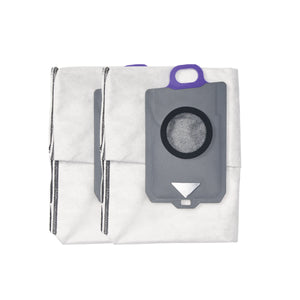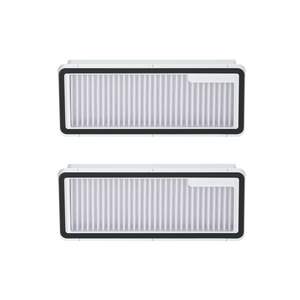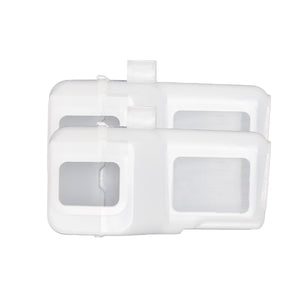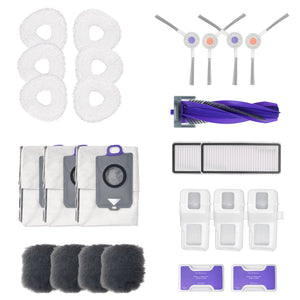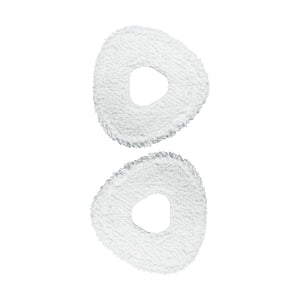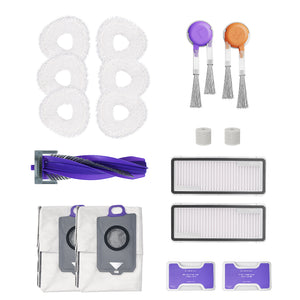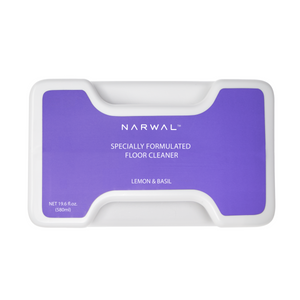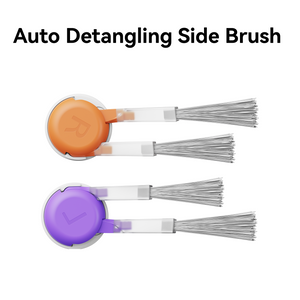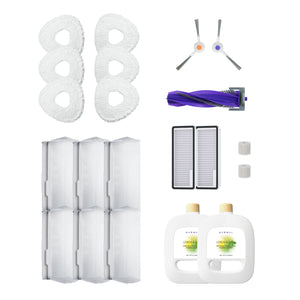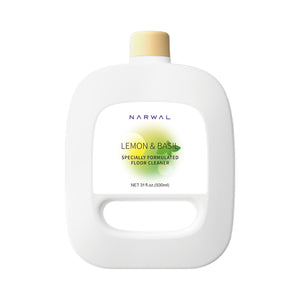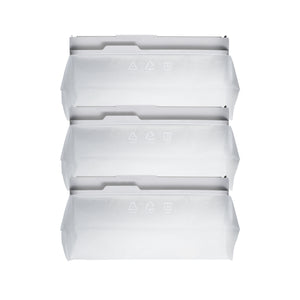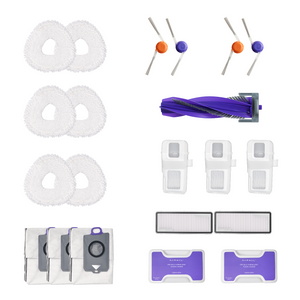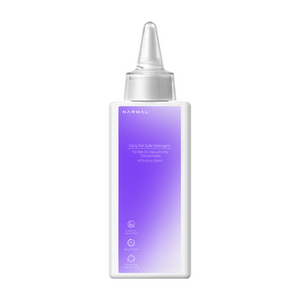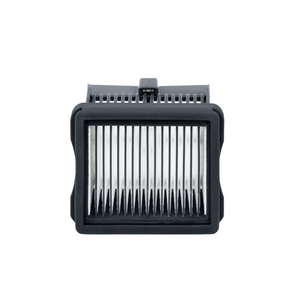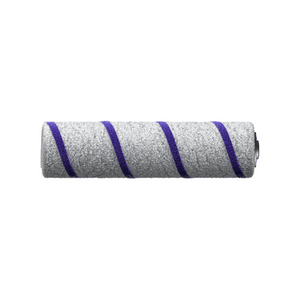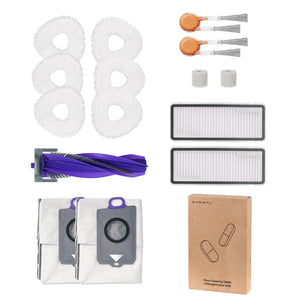Modern robot vacuums clean corners and edges far more effectively than older models, thanks to edge-detection sensors, reversing side brushes, and extending mop systems. Advanced models like Narwal Flow and Freo Z Ultra can remove over 95% of debris along walls, baseboards, and tight corners.
In this guide, we’ll show you how today’s best robot vacuums handle edge and corner cleaning using smart hardware and mapping. You’ll discover how features like Edge Mode work, what designs deliver the best results, and which models stand out for precision cleaning in 2025.
Key Robot Vacuum Designs That Improve Corner Cleaning

Key Design Elements
Side Brushes: These brushes are located on the side of the vacuum cleaner and extend outward to sweep dust and debris into the suction path of the vacuum cleaner. These brushes rotate at high speeds, making sure that even the dirt in the farthest corners is pushed into the main suction area. With their length and flexibility, these brushes are designed to reach into corners and edges efficiently. Like small brooms, they sweep debris into the path of the vacuum cleaner.
Front Spinning Brush: Some models include a front brush specifically designed to grab dust from corners and edges. This additional brush ensures that the vacuum picks up all debris, no matter how tight the spot. The front brush works in tandem with the side brush to lift and direct debris toward the suction path, enhancing the vacuum’s overall cleaning performance.
Wide Suction Channels: High-end models often come with wide suction channels near the edges of the vacuum. These channels allow the vacuum to suck up debris directly from wall edges, reducing reliance on brushes and improving overall cleaning efficiency. The wider suction path ensures that more dirt and debris are captured in a single pass, which is especially useful for cleaning along baseboards and corners.
How Robot Vacuums Sense Corners and Navigate Edges
Wondering how do robot vacuums clean corners and how do robot vacuums get into corners? It all comes down to thoughtful robot vacuum corner cleaning design, featuring advanced sensors and intelligent navigation. These systems enable robot vacuums to detect edges and baseboards automatically, positioning their cleaning mechanisms for maximum corner coverage.
Types of Sensors

These sensors are like the eyes and ears of the vacuum, helping it avoid obstacles and clean efficiently.
Infrared Sensors: Together, these sensors emit infrared beams that bounce back when they hit an object. Vacuum cleaners maximize the time it takes for the beams to return to determine the distance to an object, allowing them to accurately detect walls and corners. Infrared sensors are particularly useful for navigating in low-light conditions, ensuring the vacuum can operate effectively at any time of day.
Ultrasonic Sensors: Ultrasonic sensors use sound waves to detect objects and go around them. This helps the vacuum avoid collisions and ensures smooth navigation. Ultrasonic sensors are highly effective at detecting furniture and other obstacles, allowing the vacuum to clean around them without getting stuck.
LiDAR (Light Detection and Ranging): LiDAR technology uses laser pulses to create a detailed map of the room. By measuring the time it takes for each pulse to return, the vacuum can accurately determine its surroundings and navigate with precision. LiDAR enables the vacuum to create a real-time map of your home, allowing for efficient and systematic cleaning routes.
Gyroscopes: Gyroscopes help the vacuum maintain its orientation and maneuver around corners smoothly. They work with other sensors to ensure that the vacuum cleaner never misses a spot. Gyroscopes are particularly useful for maintaining stability and ensuring that the vacuum can navigate complex layouts without getting lost.
How Robot Vacuum Brushes Help Clean Edges and Corners
Robot vacuums rely heavily on side and front brushes to clean corners and edges effectively. Here's how they work.
Brushes are crucial for effective corner and edge cleaning in robot vacuums. While the main brush located beneath the vacuum is important, the side brushes play a pivotal role in reaching tight spaces.
Asymmetric Length: Side brushes often have longer bristles on one side, allowing them to reach deeper into corners and along edges. This design ensures that even dirt and debris stuck in tight spots are swept into the vacuum’s path. The longer bristles can flex and adapt to the shape of corners, providing thorough cleaning.
Variable Speed: Some advanced models feature variable speed side brushes. These brushes slow down near obstacles to prevent scattering dust and speed up in open areas to ensure thorough cleaning. The ability to adjust speed based on the cleaning environment helps maintain optimal performance and prevents the vacuum from pushing debris away from its path.
Edge-Cleaning Modes: Certain robot vacuums come with specific modes dedicated to cleaning edges and corners. These modes adjust the vacuum’s cleaning pattern to focus more time and effort on these areas, ensuring no corner is left uncleaned. Edge-cleaning modes can be activated through the vacuum’s app or control interface, allowing users to target specific areas that require extra attention.
Does Robot Vacuum Shape Affect Corner Cleaning?
Yes, shape makes a difference, but it is not the only factor. A square or D-shaped design can reach into corners more easily, while a round body often leaves a small gap. This is why many users feel that square robots are more corner-friendly robot vacuums.
Round models such as Roomba rely on long side brushes. They sweep dirt out of tight angles and push it into the suction path. This works for edges but not always for sharp 90-degree corners. Square or D-shape designs, on the other hand, sit flush against walls. They reduce blind spots and pick up debris that round robots may miss.
Still, body shape alone cannot solve everything. Modern robot vacuum corner cleaning design adds smart brushes and mop systems that close the gap. For example, the Narwal Flow uses a Reversing Side Brush and a Dynamic EdgeReach mop that extends to within 5 mm of the wall. Together, they deliver nearly full corner coverage even with a round body.
In short, shape helps, but technology matters more. If you want the best edge and corner cleaning, look at both the body design and the advanced cleaning systems that come with it.
Edge-Cleaning Tech from Dyson, Shark, and Others
While shape matters, some brands have developed unique edge-cleaning technologies to improve performance.
Dyson robot vacuums are known for their strong suction and premium build quality. However, Dyson continues to use a round design, which limits how close the vacuum can get to sharp corners. Like many other circular models, Dyson relies heavily on side brushes to sweep debris into the suction path. This works along straight walls but often leaves small patches of dust in 90-degree angles.
Shark has introduced its Clean Edge Technology, which uses targeted airflow to blow debris away from walls so the vacuum can then suck it up. Users often find this effective for crumbs and loose particles along baseboards. Still, it does not fully replace the precision of a brush or mop that physically reaches into corners, and it struggles with sticky grime or heavy buildup.
Compared to these approaches, Narwal’s combination of a Reversing Side Brush and Dynamic EdgeReach mop provides more consistent and thorough corner coverage. Rather than relying on airflow or side brushes alone, Narwal’s design physically scrubs and vacuums right up to the wall, making it one of the most corner-friendly robot vacuums available today.
Mapping Technologies That Improve Edge Coverage
If you’re seeking the best robot vacuums for cleaning wall edges 2025, focus on models equipped with leading mapping and navigation tools. Want to know which robot vacuums clean wall edges effectively? Advanced mapping, precise LiDAR, and edge-detector sensors allow certain brands to excel in cleaning along baseboards and edges.
SLAM (Simultaneous Localization and Mapping): SLAM technologies permit the vacuum cleaner to create a map of the environment while tracking its location. This dual functionality helps the vacuum navigate more effectively and avoid cleaning the same area twice. SLAM technology is particularly useful for large homes or complex layouts, as it ensures the vacuum covers every area systematically.
Customizable AI Maps: Advanced models often come with customizable maps that can be viewed and modified through a companion app. Users can set specific cleaning areas, create no-go zones, and even schedule cleanings for particular rooms. The ability to customize maps allows for a tailored cleaning experience, ensuring the vacuum meets the unique needs of your home.
By knowing the layout of your home, the vacuum can plan its path to ensure comprehensive coverage, including hard-to-reach corners. These mapping technologies enable the vacuum to clean more efficiently, reducing cleaning time and improving overall performance.
Tips to Boost Your Robot Vacuum’s Corner Cleaning Performance

To get the best corner and edge cleaning from your robot vacuum, consider these tips:
Clear Clutter: Remove objects that might block the vacuum’s path to corners. This includes cables, toys, and other small items that could interfere with cleaning. Keeping the floor clear of clutter allows the vacuum to navigate more effectively and reach every corner.
Regular Maintenance: Keep the sensors and brushes clean to ensure optimal performance. Check regularly for tangled hair or debris, which may affect the efficiency of your vacuum cleaner. Practicing routine maintenance will help extend the life of your vacuum cleaner and ensure that it operates at peak performance.
Strategic Dock Placement: Place the docking station in an open area to ensure the vacuum can easily find its way back. Avoid placing it in tight or cluttered spaces. An accessible docking station allows the vacuum to recharge efficiently and be ready for the next cleaning cycle.
Use Virtual Walls: Set up virtual walls or magnetic strips to guide the vacuum and focus its cleaning efforts on specific areas, including corners and edges. Virtual walls help create boundaries that direct the vacuum to areas that need extra attention while avoiding obstacles.
Schedule Frequent Cleanings: Increase the frequency of cleanings to prevent dust buildup in corners. Regular cleaning cycles ensure that dirt doesn’t accumulate over time. Frequent cleanings help maintain a consistently clean home and reduce the need for manual intervention.
Leading Robot Vacuum Models for Corner Cleaning
Not all robot vacuums perform equally when it comes to corners and edges. Some rely only on extended side brushes, while others integrate shape design and advanced edge-cleaning technologies for superior results.
Narwal Flow
Narwal Flow sets a new benchmark for corner-friendly robot vacuums. Its Dynamic EdgeReach track mop extends within 5 mm of walls, while the Reversing Side Brush sweeps hidden dust and debris out of tight corners. With 22,000 Pa Hyper Suction, Flow handles fine dust, pet hair, and crumbs that many vacuums leave behind. Its dual RGB cameras and AI-powered navigation allow it to clean precisely around obstacles without missing edge zones.
[cta:flow-robot-vacuum-and-mop]
Narwal Freo Z10
The Narwal Freo Z10 introduces a bionic hand-wiping system with a triangular mop head and 8 N downward pressure. This design scrubs along walls and into corners, removing stubborn stains that round mops often miss. Its dynamic edge-cleaning strategies adjust in real time depending on whether it encounters furniture, straight walls, or turns. With zero-tangle brush technology, Dirtsense 3.0 smart detection, and high-temperature mop washing up to 75 °C, the Z10 ensures consistent edge performance with minimal effort from the user.
[cta:narwal-freo-z10-robot-vacuum-mop]
Narwal Freo Z Ultra
The Narwal Freo Z Ultra takes edge cleaning even further with dual HD cameras and AI chips that recognize over 120 objects, allowing it to clean within 8 mm of walls and baseboards. Its EdgeSwing technology and triangular mop deliver deep edge coverage, while 12,000 Pa suction and real-time adaptive cleaning make sure every trace of dirt is captured. A self-cleaning dock sterilizes mops with hot water up to 167 °F, stores dust for 120 days, and dries everything quietly, reducing odor and maintenance.
[cta:narwal-freo-z-ultra-robot-vacuum-mop]
Some advanced models even attempt to clean baseboards. For example, Narwal Freo Z Ultra uses EdgeSwing technology to scrub dirt along skirting boards, giving it an advantage over standard edge-cleaning vacuums.
Roomba s9+
The Roomba s9+ is iRobot’s flagship D-shaped vacuum. It uses PerfectEdge Technology and a specially angled corner brush to get closer to edges and corners than standard round robots. With strong suction and precise vSLAM navigation, it performs well along baseboards and edges. Its self-emptying Clean Base station also reduces daily upkeep, though it lacks advanced mop or hot-water cleaning systems.
Roomba j7
The Roomba j7 emphasizes Precision Vision obstacle avoidance, allowing it to steer around pet accidents, cords, and small household items. Its edge-sweeping brush handles wall cleaning reliably, though it is less specialized for sharp corners compared to the s9+. The j7 is well suited for households needing reliable daily vacuuming with strong safety features but without advanced scrubbing functions. Narwal vs Roomba: Corner and Edge Cleaning Performance
Narwal vs Roomba: Corner and Edge Cleaning Performance
Here’s a side-by-side comparison of top models for corner and edge cleaning performance in 2025:
|
Feature |
Narwal Flow |
Narwal Freo Z10 |
Narwal Freo Z Ultra |
Roomba s9+ |
Roomba j7 |
|
Corner Coverage |
100% with EdgeReach mop + Reversing Side Brush |
Triangular mop + 8 N down pressure |
EdgeSwing + triangular mop, cleans to 8 mm |
D-shape + angled edge brush |
Edge-sweeping brush only |
|
Suction Power |
22,000 Pa |
15,000 Pa |
12,000 Pa |
~2,200 Pa |
~2,000 Pa |
|
Adaptive Edge Cleaning |
AI-enhanced edge focus |
DirtSense 3.0 adaptive cleaning |
Real-time adaptive EdgeSwing |
Relies on body shape + brush |
Standard sweep, no adaptive mode |
|
Self-Cleaning Base |
Mop wash, dry, auto dust storage |
6-in-1 hot-water wash & drying |
Quiet self-emptying, 120-day storage |
Clean Base auto dust empty |
Basic charging dock only |
|
Navigation & Sensors |
Dual RGB cameras + AI obstacle avoidance |
Triple laser sensors + dirt sensing |
AI cameras, 120+ object recognition |
vSLAM navigation |
Precision Vision obstacle avoidance |
|
Best Use Case |
Deep corner cleaning, pet hair, large homes |
Households with tough corner stains, pets, wood floors |
All-rounder: edges, hygiene, low-maintenance |
Edge-focused cleaning, self-empty convenience |
Daily cleaning with strong obstacle detection |
Narwal Flow, Freo Z10, and Freo Z Ultra each bring specialized innovations to corner and edge cleaning, from extendable mops and triangular designs to AI-driven edge detection. Compared to Roomba s9+ and j7, which rely more on side brushes and shape, Narwal models provide more comprehensive coverage and reduce the need for manual touch-ups. For users prioritizing corner performance and low maintenance, Narwal stands out as a clear leader.
What Users Say About Robot Vacuum Edge Cleaning
Many users agree that not all robot vacuums clean corners equally well. Round models are often praised for reliable navigation, but some people mention they still leave behind small piles of dust in tight 90-degree corners.
Owners of corner-friendly robot vacuums highlight the difference. For example, most people find that Narwal’s reversing side brush picks up more pet hair in corners than traditional round designs. Reviews also point out that the Dynamic EdgeReach mop on Narwal Flow reaches closer to walls, leaving fewer missed spots.
Feedback on the Freo Z10 and Z Ultra often mentions how the triangular mop heads provide a scrubbing effect that standard circular mops cannot match. Users describe this as especially effective in kitchens and entryways where edge grime builds up.
By comparison, Roomba s9+ receives positive comments for its D-shape design, which allows it to hug walls better than older round models. However, some users still feel that Narwal’s combination of suction, mop extension, and brush design provides more complete robot vacuum edge cleaning.
In summary, customers who switch to Narwal often highlight the improvement in corner cleaning as one of the biggest differences.
FAQs
How often should I clean the brushes and sensors on my robot vacuum?
To maintain optimal performance, it's recommended to clean the brushes and sensors of your robot vacuum at least once a week. This prevents the accumulation of hair, dust, and debris that can obstruct the sensors and reduce the effectiveness of the brushes. You may need to clean more frequently if you have pets or if the environment is particularly dusty.
Can robot vacuums clean high-pile carpets and rugs effectively?
While many robot vacuums can handle low- to medium-pile carpets and rugs, high-pile carpets can be more challenging. Some advanced models like Narwal are designed to tackle high-pile carpets with stronger suction and specialized brushes. But it's important to examine the specifications of your robot vacuum cleaner to confirm that it's suitable for use on high-pile carpets.
Do robot vacuums require any special preparation before starting a cleaning cycle?
Yes, it's beneficial to prepare your home before starting a cleaning cycle with a robot vacuum. Clear the floor of any small objects, cables, or toys that could obstruct the vacuum's path. Ensuring that the docking station is placed in an accessible, open area will help the vacuum find its way back for recharging. Scheduled maintenance ( for example, emptying the bin and cleaning the brushes) are also helpful to ensure efficient operation.
How does edge clean differ from spot clean?
Edge clean makes the robot follow walls and baseboards to remove hidden dust along the edges. Spot clean tells it to focus on a small, messy area, circling tightly until the dirt is gone.
Can robot vacuums handle door thresholds?
Most modern robot vacuums can cross transition strips and small ledges, usually between 15–20 mm high. Advanced models, like Narwal Flow, go even higher without needing manual help.
What’s the best way to set no-go zones?
You can block areas with virtual walls, magnetic strips, or app-based no-go zones. This lets you keep the robot out of certain rooms while guiding it toward corners and edges that need extra cleaning.
What is Edge Mode in a robot vacuum and how does it work?
Edge Mode is a cleaning setting where the robot vacuum follows the perimeter of a room, hugging walls and baseboards to remove dust and debris from edges. It typically activates slower brush speeds and focused suction to improve corner and edge performance.
Can robot vacuums clean along baseboards without missing spots?
Advanced robot vacuums with edge-detection sensors and reversing side brushes can clean along baseboards with high precision. However, entry-level models may still leave dust in tight areas, especially around furniture legs or in corners.
Do all robot vacuums have side brushes for corners?
Not all robot vacuums include side brushes. While most modern models use one or two side brushes to extend their reach into corners, some low-cost or older designs rely only on suction and may miss edge debris.
How often should I use edge cleaning mode for best results?
For optimal edge and corner cleaning, it's recommended to use Edge Mode 2–3 times per week, especially in high-traffic areas or homes with pets. More frequent use prevents buildup along baseboards and in tight corners.
Why the Right Robot Vacuum Matters for Corners and Edges
Robot vacuums have improved dramatically in cleaning corners and edges, turning what was once their weakness into a real strength. The key is choosing a model built with edge-focused design.
Narwal’s Flow, Freo Z10, and Freo Z Ultra go beyond standard side brushes, using extending mops, reversing brushes, and powerful suction to reach where dust hides.
If you want a cleaner home with less effort, a corner-friendly robot vacuum like Narwal is the smartest choice.
Still deciding which model is right for you? Explore Narwal’s latest robot vacuums and see which design best fits your home’s edge-cleaning needs.





















